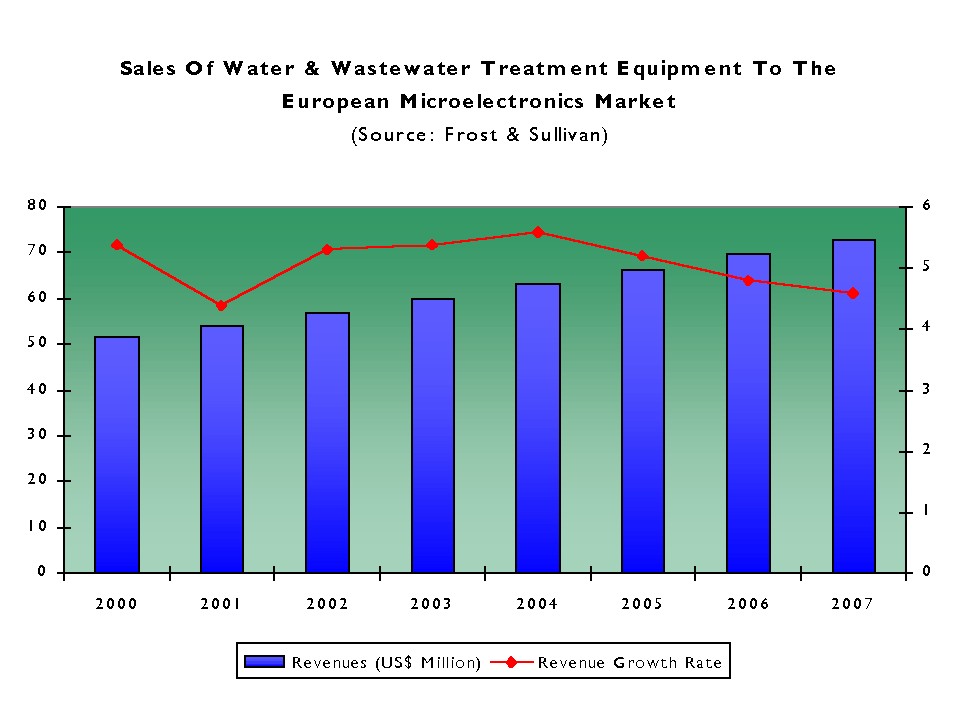
Water and wastewater treatment equipment suppliers to the microelectronics industry are in ebullient mood, despite having to identify and equip themselves to meet the challenges awaiting their companies.
A recent decline in chip sales, tightening competition and deteriorating business conditions will inevitably lead to weakened demand and a more cautious purchasing approach amongst customers. However, continued improvements in water recycling designed for the reduction of water consumption levels and the need for replacements and upgrades to allow process efficiencies will offset lacklustre business conditions.
Benefiting from the quality requirements of the burgeoning semiconductors market, sales of water and wastewater treatment equipment to the European microelectronics industry will grow from $54.0 million in 2001 to $73.0 million in 2007.
Latest findings from Frost & Sullivan, the international marketing consulting company, point to increasingly advanced process water quality specifications in microelectronics manufacturing as a further factor catalysing demand.
Saana Karki, Research Analyst at Frost & Sullivan, explains: "The purity of water used during the microelectronics manufacturing process is of paramount importance. Also, safe wastewater discharge requirements are intensifying. Demand for on-site treatment facilities is likely to persist and rise to a level of extreme sophistication."
Pressures for supplier excellence have never been greater than today.
Customers' continuous need to enhance efficiency levels and improve on-site water and wastewater treatment processes counts amongst the principal forces driving demand for water and wastewater treatment equipment in the microelectronics industry.
Ms Karki observes that the extensive and advanced on-site water treatment requirements are mainly driven by an industry-specific demand for significant volumes of ultrapure process water. Also, increasingly stringent water quality specifications due to the delicate and essential cleaning process during microelectronics production will further invigorate sales in the overall market.
Faced with greater supply choice and the possibilities of an economic downturn, microelectronics manufacturers are likely to require superior supply performance to encourage future demand for on-site treatment equipment. Thus, suppliers to the industry are forced to improve their serviceability and adaptively address demand-specific requirements in order to maintain competitive edge.
Whilst investment commitments generally remain high, a slew of new companies will be homing in on the market. In light of stiffening competition, customers' demands for service and supply are likely to become tougher and more selective.
Customers in this industry have learnt to expect the existing strong levels of supply as imperative to the service. Newcomers or those extending their service from other sectors to the microelectronics industry must accommodate their capabilities to ensure that product quality, reliability and technology as well as tailoring and complete system supply come first, in order to compete successfully in this sector.
Germany, the UK, Ireland and France emerge as the leading regional customers for water and wastewater treatment equipment in the microelectronics sector, accounting for a joint revenue share of 73 per cent.
The strong points of water and wastewater treatment equipment supply to the microelectronics industry include product quality and reliability, an efficient level of service tailoring, turnkey solutions and customer loyalty.
Ms Karki explains: "The current supply appraisals are undermined by various problems with the service level. In stark comparison to the product-related strength, all identified weaknesses involve a service-related criticism: after sales service, insufficient service capacities, delivery failures, product training and prices. While these shortcomings are a concern to the current suppliers, they provide an essential and interesting analysis for future supply trends."
The majority of water and wastewater treatment equipment suppliers questioned during Frost & Sullivan's survey agree that Pall, Millipore, Christ and Philipp Müller H+E are perceived as the dominant players in the water and wastewater treatment equipment market within the microelectronics industry.
"It is of interest to note that the list includes a mixture of specialists and original equipment manufacturers as well as process contractors and complete service providers. This indicates the head start these various types of strategists enjoy to accurately address the customer's requirements and successfully conquer the market," Ms Karki adds.
Focussing on the equipment purchasing experience, this deliverable forms part of Frost & Sullivan's water and wastewater treatment equipment customer analysis subscription services. The study explores the crucial elements of customer opinions, attitudes and supply expectations as well as the overall drivers and restraints of demand and purchasing requirements. In addition, on-site treatment technology trends, brand recognition, supplier ratings and expenditure patterns are examined in full detail.
Code: 6384, Publication Date: June 2001
For further press information, please contact Frost & Sullivan's Public Relations Department
Tel. +44 (0) 20 7343 8376 or Fax. +44 (0) 20 7343 8380 (kristina.menzefricke@fs-europe.com)


